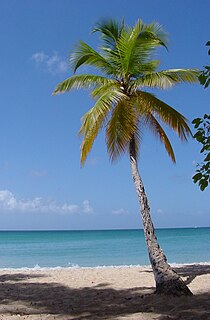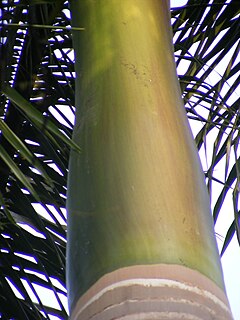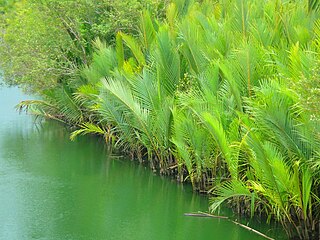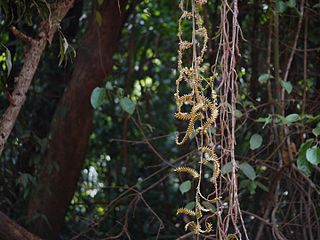 W
WThe Arecaceae are a botanical family of perennial flowering plants in the monocot order Arecales. Their growth form can be climbers, shrubs, tree-like and stemless plants, all commonly known as palms. Those having a tree-like form are called palm trees. Currently 181 genera with around 2,600 species are known, most of them restricted to tropical and subtropical climates. Most palms are distinguished by their large, compound, evergreen leaves, known as fronds, arranged at the top of an unbranched stem. However, palms exhibit an enormous diversity in physical characteristics and inhabit nearly every type of habitat within their range, from rainforests to deserts.
 W
WPalms are symbolically important in the Caribbean, appearing on the coats of arms of several Caribbean nations and on the flag of the West Indies cricket team. In 2004, Carlo Morici reported that there are about 191 genera and 2339 species of Arecaceae, the palm family. Their distribution is biased toward islands - 36% of genera and 52% of species are found only on islands, while 32% of genera and 6% of species are found only on continents. Sixty-two percent of monotypic genera are found only on islands.
 W
WAn elongated circumferential leaf base formation present on some species of palm is called a crownshaft.
 W
WFan palm as a descriptive term can refer to any of several different kinds of palms (Arecaceae) in various genera with leaves that are palmately lobed. Most are members of the subfamily Coryphoideae, though a few genera in subfamily Calamoideae also have palmate leaves. Fan palm genera include:Bismarckia Borassus Coccothrinax Copernicia Hyphaene Licuala Pritchardia Rhapidophyllum Rhapis Sabal Thrinax Trachycarpus Trithrinax
 W
WHardy palms are any of the species of palm (Arecaceae) that are able to withstand brief periods of colder temperatures and even occasional snowfall. A few palms are native to higher elevations of south Asia where true winter conditions occur, while a few others are native to the warmer parts of the temperate zone in North America. A few of these temperate climate palms can tolerate hard freezes with little or no damage. Many of these "hardy " species can be cultivated in warmer parts of temperate climates.
 W
WHistoria naturalis palmarum: opus tripartitum is a highly illustrated, three-volume botanical book of palms (Arecaceae) by German botanist Carl Friedrich Philipp von Martius. The work is in Latin and was published in imperial folio format in Leipzig (Lipsiae) by T.O. Weigel, volume one in 1823 and the final volume in 1850. It includes more than 550 pages of text and 240 chromolithographs, including views of habitats and botanical dissections.
 W
WLatanites is an extinct genus of plants belonging to the family Arecaceae.
 W
WNypa fruticans, commonly known as the nipa palm or mangrove palm, is a species of palm native to the coastlines and estuarine habitats of the Indian and Pacific Oceans. It is the only palm considered adapted to the mangrove biome. This species is the only member of the genus Nypa and the subfamily Nypoideae, forming monotypic taxa.
 W
WThe oldest palm tree in Los Angeles is in Exposition Park, where it has survived for more than a century following its transplanting on September 5, 1914. It may be the most-often-moved palm in the city.
 W
WMiel de palma is an edible sweet syrup produced from the sap of a number of palms. It is produced in the Canary Islands and coastal regions of South America.
 W
WPhoenicites is a genus of fossil flowering plants belonging to the Angiospermae.
 W
WRattan is the name for roughly 600 species of old world climbing palms belonging to subfamily Calamoideae. Rattan is also known as manila, or malacca, named after the ports of shipment Manila and Malacca City, and as manau. The climbing habit is associated with the characteristics of its flexible woody stem, derived typically from a secondary growth, makes rattan a liana rather than a true wood.